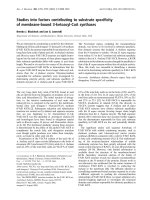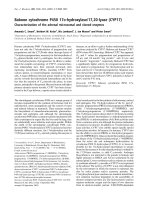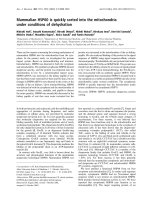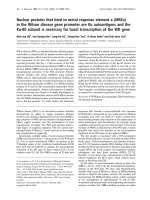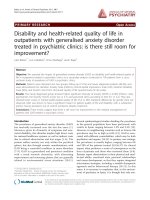Báo cáo y học: "QT interval prolongation related to psychoactive drug treatment: a comparison of monotherapy versus polytherapy" pdf
Bạn đang xem bản rút gọn của tài liệu. Xem và tải ngay bản đầy đủ của tài liệu tại đây (313.98 KB, 6 trang )
BioMed Central
Page 1 of 6
(page number not for citation purposes)
Annals of General Psychiatry
Open Access
Primary research
QT interval prolongation related to psychoactive drug treatment: a
comparison of monotherapy versus polytherapy
Michela Sala*
1
, Alessandro Vicentini
2
, Paolo Brambilla
4
,
Cristina Montomoli
3
, Jigar RS Jogia
6
, Eduardo Caverzasi
1
, Alberto Bonzano
1
,
Marco Piccinelli
5
, Francesco Barale
1
and Gaetano M De Ferrari
2
Address:
1
Department of Health Sciences-Section of Psychiatry, IRCCS Policlinico S. Matteo, University of Pavia, School of Medicine, Pavia, Italy,
2
Department of Cardiology, IRCCS Policlinico S. Matteo, University of Pavia, School of Medicine, Pavia, Italy,
3
Department of Health Sciences,
University of Pavia, Pavia, Italy,
4
Department of Pathology and Experimental and Clinical Medicine, Section of Psychiatry, University of Udine
School of Medicine, Udine, Italy,
5
Psychiatry Unit, Azienda Ospedaliera Universitaria Ospedale di Circolo e Fondazione Macchi di Varese, Presidio
Ospedaliero del Verbano – Italy and
6
Section of Neurobiology of Psychosis, Institute of Psychiatry, London, UK
Email: Michela Sala* - ; Alessandro Vicentini - ;
Paolo Brambilla - ; Cristina Montomoli - ; Jigar RS Jogia - ;
Eduardo Caverzasi - ; Alberto Bonzano - ; Marco Piccinelli - ;
Francesco Barale - ; Gaetano M De Ferrari -
* Corresponding author
antipsychoticantidepressantproarrhythmiaQTc interval
Abstract
Background: Several antipsychotic agents are known to prolong the QT interval in a dose
dependent manner. Corrected QT interval (QTc) exceeding a threshold value of 450 ms may be
associated with an increased risk of life threatening arrhythmias. Antipsychotic agents are often
given in combination with other psychotropic drugs, such as antidepressants, that may also
contribute to QT prolongation. This observational study compares the effects observed on QT
interval between antipsychotic monotherapy and psychoactive polytherapy, which included an
additional antidepressant or lithium treatment.
Method: We examined two groups of hospitalized women with Schizophrenia, Bipolar Disorder
and Schizoaffective Disorder in a naturalistic setting. Group 1 was composed of nineteen
hospitalized women treated with antipsychotic monotherapy (either haloperidol, olanzapine,
risperidone or clozapine) and Group 2 was composed of nineteen hospitalized women treated with
an antipsychotic (either haloperidol, olanzapine, risperidone or quetiapine) with an additional
antidepressant (citalopram, escitalopram, sertraline, paroxetine, fluvoxamine, mirtazapine,
venlafaxine or clomipramine) or lithium. An Electrocardiogram (ECG) was carried out before the
beginning of the treatment for both groups and at a second time after four days of therapy at full
dosage, when blood was also drawn for determination of serum levels of the antipsychotic.
Statistical analysis included repeated measures ANOVA, Fisher Exact Test and Indipendent T Test.
Results: Mean QTc intervals significantly increased in Group 2 (24 ± 21 ms) however this was not
the case in Group 1 (-1 ± 30 ms) (Repeated measures ANOVA p < 0,01). Furthermore we found
Published: 25 January 2005
Annals of General Psychiatry 2005, 4:1 doi:10.1186/1744-859X-4-1
Received: 06 July 2004
Accepted: 25 January 2005
This article is available from: />© 2005 Sala et al; licensee BioMed Central Ltd.
This is an Open Access article distributed under the terms of the Creative Commons Attribution License ( />),
which permits unrestricted use, distribution, and reproduction in any medium, provided the original work is properly cited.
Annals of General Psychiatry 2005, 4:1 />Page 2 of 6
(page number not for citation purposes)
a significant difference in the number of patients who exceeded the threshold of borderline QTc
interval value (450 ms) between the two groups, with seven patients in Group 2 (38%) compared
to one patient in Group 1 (7%) (Fisher Exact Text, p < 0,05).
Conclusions: No significant prolongation of the QT interval was found following monotherapy
with an antipsychotic agent, while combination of these drugs with antidepressants caused a
significant QT prolongation. Careful monitoring of the QT interval is suggested in patients taking a
combined treatment of antipsychotic and antidepressant agents.
Background
The QTc interval is a heart rate corrected value that meas-
ures the time between the onset and the end of electrical
ventricular activity. Prolongation of this interval is consid-
ered a marker of the arrhythmogenic potential of a drug
specifically linked to an increased risk of torsade de
pointes ventricular tachycardia [1].
According to a document presented by the Committee for
Proprietary Medicinal Products (CPMP) in 1997, normal
subjects can be divided into three groups based on QTc
interval length. For males, QTc values less than 430 ms are
normal, between 431 and 450 ms are borderline and over
450 ms are prolonged. Whereas for females QTc values
less than 450 ms are normal, between 451 and 470 ms are
borderline and over 470 ms are prolonged [2].
This sex difference appears to be androgen driven and not
determined by female hormones: at birth, QTc interval
measurements are the same for male and female infants.
At puberty, the male QTc interval shortens and remains
shorter than its female counterpart by about 20 ms until
ages 50 to 55 years, coincident with a decline in testoster-
one levels moreover, baseline QTc interval duration
doesn't show significant fluctuations during the men-
strual cycle and Hormone Replacement Therapy in post-
menopausal age doesn't affect QTc interval [3].
In the above mentioned CPMP document it was also sug-
gested that individual changes of QTc length of between
30 and 60 ms from baseline raises concern for the poten-
tial risk of drug induced arrhythmias [2].
Antipsychotics such as thioridazine, ziprasidone, quetiap-
ine, risperidone, olanzapine or haloperidol have been
suggested to prolong QTc interval [4-7].
Some authors reported that antidepressant drugs, includ-
ing Selective Serotonine Reuptake Inhibitors (SSRI) (flu-
voxamine, paroxetine and sertraline), Tricyclic
Antidepressants (TCA) (amytriptiline, clomipramine,
imipramine), and lithium can also prolong QTc interval
[8-10].
Almost all drugs causing significant QT prolongation are
known to interact with repolarizing potassium channels,
particularly with the rapid component of delayed rectifier
potassium currents (I
kr
), encoded by the human Ether-a-
go-go related gene (HERG) [11].
However, TCA agents may affect the QTc interval prima-
rily by their effect on sodium channels during depolariza-
tion [12]. Nonetheless TCA can also affect HERG
potassium channels [13].
Drug trapping and structure-function studies suggest that
the inner cavity of HERG channels is larger than other
voltage-gated potassium channels and is therefore able to
accommodate diverse chemical structures [14]. Among
those drugs there are also SSRI like fluvoxamine [15], cit-
alopram [16] and fluoxetine [17].
The combination of antipsychotic and antidepressant
agents seems to have addictive effects on QTc interval
[18].
We investigated the effects of polypharmacy on QTc in
two groups of psychiatric female inpatients. Our null
hypothesis was that patients treated with antipsychotics
plus antidepressants or lithium would not have a greater
QTc prolongation, if any, than patients treated with antip-
sychotics alone.
Methods
A prospective naturalistic observational study was con-
ducted in the Department of Psychiatry of San Matteo
Hospital in Pavia. The study was approved by local Ethics
Review Committee.
We chosed to recruit only women because of their higher
risk of developing drug related arrythmias. Consecutive
female inpatients admitted from August 2003 to April
2004, with schizophrenia, bipolar disorder or schizoaffec-
tive disorder, were considered eligible for the study. Diag-
noses were made by two staff psychiatrists (one attending
and one resident psychiatrist), after reaching a clinical
consensus in accordance to the DSM IV.
Pharmacological and medical history were obtained.
Annals of General Psychiatry 2005, 4:1 />Page 3 of 6
(page number not for citation purposes)
Included patients had to be free from psychiatric medica-
tions for at least 48 hours. Patients who were taking fluox-
etine untill three days before recruitment were excluded,
because of the long half life of this drug (3–5 days). Also
patients treated with depot preparations were excluded.
Non psychoactive drugs, like cardiovascular drugs, were
allowed only if they were not reported to alter QT interval.
Patients with disturbances of cardiac rate and rhythm, his-
tory of prolonged QTc, family history of sudden death,
QTc interval greater than 470 ms in the ECG performed at
admission, alterations of hepatic or renal function and
substance abusers patients were also excluded.
For each subject, therapy was started according to the clin-
ical evaluation of psychiatrist in charge of the patient. The
first group (Group 1) included women who were treated
with only an antipsychotic (concomitant benzotropine
treatment was permitted, as also zolpidem for insomnia
was), the second group (Group 2) was composed of
female patients who started treatment with antipsychotics
in association with either an antidepressant or lithium.
The dosage equivalent of haloperidol was calculated [19].
Two ECGs were obtained for each patient, the first before
the beginning of treatment and the second after four days
of treatment with the patients on the full therapeutic daily
dose of antipsychotic prescribed by the clinician, gener-
ally after one week from the beginning of the treatment,
except for the patients treated with clozapine, who had
the second ECG four days after the end of titration (gener-
ally after two weeks of therapy).
On the same day of the first ECG, blood samples were
drawn for the evaluation of potassium serum levels from
all the participants. When the second ECG was adminis-
tered, blood was drawn to obtain potassium and addi-
tionally magnesium serum levels as well as serum levels of
the antipsychotic agent.
Samples for plasmatic levels determination were drawn
before the first drug dose in the morning. Serum antipsy-
chotic levels were analyzed by high-performance liquid
chromatography with ultraviolet detection.
The ECGs were obtained by standard 3-leads resting ECG
procedure in the supine position and analyzed by a resi-
dent cardiologist (A. V.) who was blind to the patient's
condition, study hypothesis, treatment status, serum lev-
els of antipsychotics and was not involved in patient care.
The QTc interval was calculated with the Bazzett formula.
The QT interval was assessed in both DII and V2 leads. It
was decided to focus on DII leads measurements due to
the higher variability of measurements in precordial leads.
Statistical Analysis
A repeated measures analysis of variance was used to test
the effect of treatments on QTc (within subject factor:
time of ECG examination, between subject factor: therapy
group). Fisher Exact Test was used to compared the
number of patients who exceed the threshold of border-
line QTc values in Group 1 and Group 2. Indipendent T-
Sample Tests were used to test the differences between
baseline QTc values, ages and duration of illness using the
statistical package Stata 7.0 (Stata Coorporation, 2001).
Results
Patients' characteristics
Our sample consisted of thirty eight women. Ninenteen
were included in the Group 1 and ninenteen in the Group
2.
Age and duration of illness were comparable between the
two groups (Table 1).
Table 1: Diagnosis, duration of illness, psychoactive treatment before recruitment and age of patients
Diagnosis Comorbid
Disorders (N)
Duration of illness
(yr)
Psychoactive
treatment 48
hours before
recruitment (N)
Age (yr) Mean ±
SD
Age (yr) Range
Group 1 Patients
in monotherapy
Schiz 17
Schizoaf 2
0 5,8 ± 5 Haloperidol 3
Risperidone 2
45,7 ± 15 22–77
Group 2 Patients
in politherapy
Schizoaf 10
Bip Dis 3
Schiz 6
An Nervosa 2
Alc Abuse 2
4,2 ± 3 Venlafaxine 2
Haloperidol 1
Risperidone 2
Atenolole 2
Lacipidine 1
Amlodipine 1
Ranitidine 1
45,79 ± 12,8 26–74
Schizoaf: Schizoaffective Disorder; Schiz: Schizophrenia; Bip Dis: Bipolar Disorder; An Nervosa: norexia Nervosa; Alc Abuse: Alcohol Abuse yr:
years
Annals of General Psychiatry 2005, 4:1 />Page 4 of 6
(page number not for citation purposes)
Data on diagnosis and previous pharmacological treat-
ment of patients are reported in Table 1.
Among the nineteen patients in Group 1, five were treated
with haloperidol, five with olanzapine, five with risperi-
done and four with clozapine; among the nineteen
patients of group 2, five started haloperidol, eight olanza-
pine, four risperidone and two quetiapine. Antidepressant
used were escitalopram (two patients), citalopram (three
patients), mirtazapine (four patients), paroxetine (one
patients), sertraline (two), fluvoxamine (one patient),
venlafaxine (three patients), clomipramine (two
patients). Three patients started also lithium treatment.
The mean antipsychotic doses, equivalent doses and
mean plasmatic levels are reported in Table 2 (See Addi-
tional file 1 ). Potassium and magnesium serum levels
were always within the normal range for all subjects.
QTc interval
Mean baseline QTc intervals were similar in the two
groups: 422 ± 26 ms in group 1 and 414 ± 22 ms in group
2 (Indipendent T-test p > 0,5). One patient in the mono-
therapy group, who started clozapine treatment, was
excluded from this analysis and from pre-post treatment
comparisons because QTc in DII was not measurable with
sufficient accuracy.
Three patients in the first group had QTc values that
exceeded 450 ms at baseline while no patients in Group 2
exceeded this threshold before starting treatment.
The average QTc interval after treatment was 421 ± 20 ms
in the monotherapy group (range 391–452) and 438 ± 30
and in the polytherapy group (range 379–488)
(Indipendent T test, p < 0,05).
Compared with the baseline, mean QTc change after treat-
ment was – 1 ± 30 ms in Group 1 and 24 ± 21 ms in Group
2 (repeated measures ANOVA p < 0,05).
After treatment only one patient in Group 1 reached the
threshold for borderline values of QTc interval in compar-
ison to seven patients in Group 2 (Fisher Exact Text p <
0,05).
Moreover, in Group 2 two patients had a QTc exceeding
480 ms.
The highest prolongations of QTc intervals (66 ms and 55
ms) were found in two patients taking risperidone, the
first in association to clomipramine and the second in
association to escitalopram. However in these two cases
plasmatic dosages of antipsychotics were not higher than
in other patients who reported a shorter QTc
prolongation.
Discussion
We found that the psychiatric population treated with
antipsychotic monotherapy had much less risk of devel-
oping an increase in QTc interval compared to those
treated with antipsychotics plus an antidepressant or
lithium.
Two main mechanisms seem to operate in determining
the prolongation of QTc interval during treatment with
different combinations of psychoactive drugs. The first is
the synergic blockade of the HERG potassium channels,
the second is the increase in drug levels (with subsequent
augmented risk of cardiotoxicity) due to metabolic inter-
actions between drugs that share the same metabolic
pathway [20]. This mechanism may be particularly rele-
vant in subject with genetic-determined impairment of
CYP2D6 and CYP3A4 drug-metabolizing enzymes (poor
metabolizer subjects) [21].
In our study, metabolic interactions leading to abnormal
elevation of serum levels of antipsychotics did not seem to
be the principal determinant of the greater QTc prolonga-
tion in the group with combined therapy. Indeed serum
levels of antipsychotics were all within or under the
expected range after therapeutic dosing in both groups,
they were not higher in Group 2 compared to Group 1
and the highest prolongations observed were not associ-
ated with the highest antipsychotic serum levels.
Recently, Harringan et al [22] analyzed, in a prospective
randomized study, the effects of six antipsychotics on the
QTc interval; they found that each of the antipsychotics
were associated with measurable QTc prolongation which
was not augmented by concomitant use of metabolic
inhibitors, even if in their study plasmatic levels of antip-
sychotics raised after the addition of the specific meta-
bolic inhibitor.
In our study, the combination of different drugs doesn't
seem to cause strong interactions on drug metabolism.
However, in our sample, the combination of drugs that
specifically interfere in their own methabolism, like flu-
voxamine and olanzapine, paroxetine and risperidone,
were avoided by clinicians.
Antidepressant used in our study have a mild inhibitory
action on antipsychotic methabolism and this can explain
why antipsychotic serum levels didn't raise in Group 2
compared to Group 1. It is reassuring to find that signifi-
cant pharmacokinetic interactions do not occur when the
antipsychotics studied were coadministered with antide-
pressant commonly used in clinical practice.
Annals of General Psychiatry 2005, 4:1 />Page 5 of 6
(page number not for citation purposes)
If the metabolic interactions do not seem to be the most
important explanation for our results, an alternative
explanation might be the synergic actions of different
drugs on ion channels.
The two patients with the highest prolongations were
both taking risperidone, which is noted to block the I
kr
current [23,24]. Actually, many psychotropic drugs share
this capacity to inhibit I
kr
current, including not only
antipsychotic agents but also antidepressant agents like
citalopram, fluoxetine, paroxetine [16,23]. Those agents
may have synergic effect when used in combination.
This study has several limitations, most of them related to
the naturalistic setting of this study: we chosed to admin-
ister the second ECG after four days of therapy at full dos-
age (generally after one week from recruitment) because
all antipsychotic used reached the steady-state in 3–5
days. Actually we couldn't chose a longer interval between
the first and the second ECG because the average duration
of recovery in our ward is 8,5 days. Dosing was clinically
determined for symptom response by the treating psychi-
atrist and hence, doses varied within and between groups.
Moreover statistical comparison of QTc interval changes
among agents was not possible because of the small
number of the samples.
Finally we didn't measure antidepressant serum levels.
Consistently with data reported in literature, we thought
that antipsychotic would have been the principal drugs
involved in QTc prolongation, while antidepressant
would have only a role of potentiating agents. Actually,
serum levels of antidepressants would have helped to
explain the greater prolongation observed in Group 2.
Conclusions
Prolongation of the QT interval by a non cardiovascular
drug including notably an antipsychotic agent is consid-
ered a good marker of the arrythmogenic potential of that
agent [1].
Psychiatric patients had been identified as a population at
risk for cardiovascular problems [12,25]. Mortality rates
are higher in psychiatric patients than in the general pop-
ulation [26] and the pharmacological treatment itself
might produce side effects that affect mortality from
causes other than suicide [27].
There is a vast amount of evidence available showing the
effect of a single antipsychotic on QTc interval however
there is not much evidence obtained for clinical popula-
tions treated with a different combinations of drugs.
Interestingly, the response to repolarization prolonging
stimuli is "patient-specific" [9]. Thus, detecting the
patients with a reduced repolarization reserve [28,29] will
lead to personalized psychotropic therapy according to
the predisposition of that patient to develop cardiac side
effects with a certain drug.
In view of the fact that psychiatric patients are considered
high risk subjects and since they frequently show electro-
lytes unbalances [30], an accurate monitoring of the QTc
interval before and after the beginning of treatment
appears warranted, particularly for patients taking multi-
ple psychoactive drugs, sharing QTc prolonging
properties.
Further observational studies on larger samples of
patients, comparing QTc intervals, plasmatic levels of
antipsychotics and daily doses of psychotropic drugs are
necessary to perform statistical comparisons for each kind
of antipsychotic and for each kind of antipsychotic-anti-
depressant association commonly used in clinical
practice.
Competing interest
The author(s) declare that they have no competing
interests.
Author's contributions
MS recruited and assessed participants and conceived of
the study, and participated in its design and coordination.
AV and GMD read ECGs and measured the QTc and ana-
lysed the results. CM ran the statistical analysis. AB and EC
Mean QTc (bars indicate standard deviations) values at base-line (T0) and after four days at full dosage (T1) of antipsy-chotic therapy, in the monotherapy (1) and politherapy (2) groupsFigure 1
Mean QTc (bars indicate standard deviations) values at base-
line (T0) and after four days at full dosage (T1) of antipsy-
chotic therapy, in the monotherapy (1) and politherapy (2)
groups.
Publish with BioMed Central and every
scientist can read your work free of charge
"BioMed Central will be the most significant development for
disseminating the results of biomedical research in our lifetime."
Sir Paul Nurse, Cancer Research UK
Your research papers will be:
available free of charge to the entire biomedical community
peer reviewed and published immediately upon acceptance
cited in PubMed and archived on PubMed Central
yours — you keep the copyright
Submit your manuscript here:
/>BioMedcentral
Annals of General Psychiatry 2005, 4:1 />Page 6 of 6
(page number not for citation purposes)
participated in the assessment of participants. MP, PB,
JRSJ and FB participated in its design and coordination
and the interpretation of results.
Additional material
Acknowledgements
Dr. Michela Sala was supported by a fellowship from Fondazione Polizzo-
tto- Milano (Italy).
References
1. Haddad PM, Anderson IM: Antipsychotic-related QTc prolonga-
tion, torsade de pointes and sudden death. Drugs 2002,
62:1649-71.
2. Committee for Proprietary Medicinal Products: Point to consider:
the assessment of the potential for QT interval prolongation
by non cardiovascular medicinal products. [http://
www.emea.eu.int/pdfs/human/swp/098696en.pdf]. December 17,
1997
3. Abi-Gerges N, Philp K, Pollard C, Wakefield I, Hammond TG, Valen-
tin JP: Sex differences in ventricular repolarization: from car-
diac electrophysiology to Torsades de Pointes. Fundam Clin
Pharmacol 2004, 18:139-51.
4. Angelink M, Majewski T, Wurthmann C, Lukas K, Ullrich H, Linka T,
Klieser E: Effects of newer atypical antipsychotics on auto-
nomic neurocardiac function: a comparison between amisul-
pride, olanzapine, setindole, and clozapine. J Clin
Psychopharmacology 2001, 21:8-13.
5. Czekalla J, Kollack-Walker S, Beasley CM: Cardiac Safety param-
eters of olanzapine: comparison with other atypical and typ-
ical antipsychotics. J Clin Psychiatry 2001, 62(Suppl 2):35-40.
6. Food and Drug Administration: Psychopharmacological Drugs
Advisory Committee. Briefing Document for Zeldox Cap-
sules (ziprasidone HCl). . July 19, 2000 />dockets/ac/00/backgrd/3619b1a.pdf, />ets/ac/00/backgrd/3619b1b.pdf
7. Food and Drug Administration: Center for Drug Evaluation and
Research Psychopharmacological Drugs Advisory Com-
mitee. Meeting Transcript. . July 19, 2000 />ohrms/dockets/ac/00/transcripts/3619t1a.pdf, />ohrms/dockets/ac/00/transcripts/3619t1b.pdf, />ohrms/dockets/ac/00/transcripts/3619t1c.pdf
8. Elming H, Sonne J, Lublin HKF: The importance of the QT inter-
val: a review of the literature. Acta Psychiatr Scand 2003,
107:96-101.
9. Haverkamp W, Breithardt G, Camm AJ, Janse MJ, Rosen MR, Ant-
zelevitch C, Escande D, Franz M, Malik M, Moss A, Shah R: The
potential for QT prolongation and pro-arrhythmia by non-
anti-arrhythmic drugs: Clinical and regulatory implications
Report on a Policy Conference of the European Society of
Cardiology. Cardiovasc Res 2000, 47:219-33.
10. Rodriguez de la Torre B, Dreher J, Malevany I, Bagli M, Kolbinger M,
Omran H: Serum Levels and cardiovascular effects of tricyclic
antidepressants and selective serotonine reuptake inhibitors
in depressed patients. Ther Drug Monit 2001, 23:435-440.
11. Tie H, Walker BD, Valenzuela SM, Breit SN, Campbell TJ: The Heart
of Psychotropic drug therapy. Lancet 2000, 355:1825.
12. Glassmann AH: Clinical Management of cardiovascular risks
during treatment with psychotropic drugs. J Clin Psychiatry
2002, 63(Suppl 9):12-7.
13. Teschemacher AG, Seward EP, Hancox JC, Witchel HJ: Inhibition of
the current of heterologously expressed HERG potassium
channels by imipramine and amitriptyline. Br J Pharmacol 1999,
128:479-485.
14. Mitcheson JS: Drug binding to HERG channels:evidence for a
"non-aromatic" binding site for fluvoxamine. Br J Pharmacol
2003, 139:883-884.
15. Milnes JT, Crociani O, Arcangeli A, Hancox JC, Witchel HJ: Block-
ade of HERG potassium currents by fluvoxamine: incom-
plete attenuation by S6 mutations at F656 or Y652. Br J
Pharmacol 2003, 139:887-898.
16. Witchel HJ, Pabbathi VK, Hofmann G, Paul AA, Hancox JC: Inhibi-
tory actions of the selective serotonine re-uptake inhibitor
citalopram on HERG and ventricular L-type calcium
currents. FEBS 2002, 512:59-66.
17. Thomas D, Gut B, Wendt-Nordahl G, Kiehn J: The antidepressant
drug fluoxetine is an inhibitor of human ether-a-go-go-
related gene (HERG) potassium channels. J Pharmacol Exp Ther
2002, 300:543-8.
18. Reilly JG, Ayis SA, Ferrier IN, Jones SJ, Thomas SHL: QTc-interval
abnormalities and psychotropic drug therapy in psychiatric
patients. Lancet 2000, 355:1048-52.
19. Piccinelli M: Antipsicotici Vademecum per lo psichiatra italiano 2004.
20. Facciollà G, Scordo MG: Citocromo P450 e interazioni tra
farmaci. [
].
21. Idle JR: The Heart of Psychotropic drug therapy. Lancet 2000,
355:1824.
22. Harringan EP, Miceli JJ, Anziano R, Watsky E, Reeves KR, Cutler NR,
Sramek J, Shiovitz T, Middle M: A randomized evaluation of the
effects of six antipsychotic agent on the QTc, in the absence
and presence of metabolic inhibition. J Clin Psychopharmacol
2004, 24:62-9.
23. Kongsamut S, Kang J, Chen XL, Roehr J, Rampe D: A comparison
of the receptor binding and HERG channels affinities for a
series of antipsychotic drugs. Eur J Pharmacol 2002, 450:37-41.
24. Magyar J, Banyasz T, Bagi Z, Pacher P, Szentandrassy N, Fülöp L, Kec-
skemeti V, Nanasi PP: Electrophysiological effects of risperi-
done in mammalian cardiac cells. Naunyn-Schmiedeberg's Arch
Pharmacol 2002, 366:350-6.
25. Ruschena D, Mullen PE, Burgess P, Cordner SM, Barry-Walsh J,
Drummer OH, Palmer S, Browne C, Wallace C: Sudden death in
psychiatric patients. Br J Psychiatry 1998, 172:331-6.
26. Politi P, Piccinelli M, Klersy C, Madini S, Segagni LG, Fratti C, Barale
F: Mortality in psychiatric patients 5 to 21 years after hospital
admission in Italy. Psychol Med 2002, 32:227-37.
27. Hannerz H, Borga P: Mortality among persons with a history as
psychiatric inpatients with functional psychosis. Soc Psychiatry
Psychiatr Epidemiol 2000, 35:380-7.
28. Roden DM: Taking the "idio" out of "idiosyncratic": predicting
torsades se pointes. PACE 1998, 21:1029-34.
29. Redfern WS, Carlsson L, Davis AS, Lynch WG, MacKenzie I,
Palethorpe S: Relationship between preclinical electrophysiol-
ogy, clinical QT interval prolongation and torsade de pointes
for a broad range of drugs: evidence for a provisional safety
margin in drug development. Cardiovasc Res 2003, 58:32-45.
30. Hatta K, Takahashi T, Nakamura H, Yamashiro H, Yonezawa Y: Pro-
longed QT interval in acute psychotic patients. Psychiatry Res
2000, 94:279-85.
Additional File 1
Additional file 1: Table 2.doc
Click here for file
[ />859X-4-1-S1.doc]


